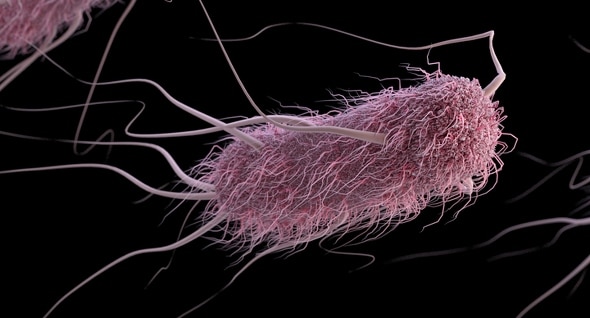Create a free profile to get unlimited access to exclusive videos, sweepstakes, and more!
Watch Evolution Occur Before Your Eyes

This is truly stunning: Scientists have released a video showing evolution in action.
They built a table more than a meter long and put down a culture agent that allows bacteria (specifically, E. coli) to grow. But they set it up in a very interesting way. At each end of the table they allowed the bacteria to grow freely. But just inside these free zones they slathered a broad swath of an antibacterial substance, at a dose just more than enough to kill the critters. Then, next to those, they put down stripes at a dose 10 times that needed to kill them. Next to those were stripes 100 times the lethal dose, and then finally, in the center, a hyper-deadly patch 1,000 times stronger than needed to kill the original strain.
The video of what happens is staggering. Watch:
Yegads. Now, to be clear, we know this sort of evolution can happen, because it’s been seen both in the lab and in the world; antibacterial resistant diseases are popping up all over the place and are a real threat. We’ve also seen bacteria evolve in real time; a similar experiment (minus the video) was done with E. coli that shows them evolving to eat citrate, something they couldn’t do before.
The difference here is just how visual the video is. The bacteria seem to be stopped by the lethal barrier, but they still reproduce near the border. When they do, random mutations in the genetic code occur, and at some point one or more of the baby bacteria just happened to get a resistance to the drug. It was able to pass that mutation on, and when it does, the new bacteria spread outward like an alluvial fan from a flood.
Mind you, bacteria all over the place on the table were probably evolving some sort of resistance, but only the ones near the edge were able to spread out into the Forbidden Zone. As you can see, it happened multiple times as well in each strip.
The researchers noted they could also see phenotypical (structural) changes in the bacteria as well. That’s not surprising, but it’s still rather amazing to know. Note that the doubling rate (the time it takes for the population to double) for E. coli is about 20 minutes, which is one reason it makes this particular bacterium useful for this experiment. The entire video covers about two weeks of real time.
This video will be a powerful tool for teachers to show their students how evolution works. I’ll note though that it may not actually help convince creationists. A poll of Americans shows that an overwhelming majority of them (90 percent) believe bacteria can evolve a resistance to drugs, but only about 60 percent believe that humans evolved through natural selection. Some people pick and choose their science—not a terribly scientific attitude—and the ones who don’t believe in evolution probably won’t be swayed by a video like this.
It’s hard to know what will sway them, though I’ve found being polite and answering their questions simply (and showing where those questions are ill-posed, no doubt because they get their science from people who don’t understand it) can help. It won’t work with everyone, but I strongly suspect it works a lot better than mocking them.
Even so, I reserve the right to point out just how ridiculously wrong legislators can be when it comes to this topic, too.
Still, this video is amazing, and I hope as many people see it as possible. I think it can help show the reality of evolution (imagine this process running not just two weeks, but for, say 2 billion years) and how complex life could have evolved from simpler samples. Because that is reality, and I think it’s our duty, and our privilege, to understand how we came to be.














